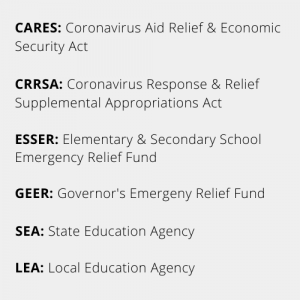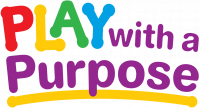updated: March 16th, 2021
It’s easy to get overwhelmed with an excess of information especially as it pertains to the past year. As teachers, you know that delivering information in an organized fashion is especially important when teaching new subjects to your students. So, when we are bombarded with government vernacular in an environment never before experienced, or “unprecedented” as our officials have repeated time and time again, it can be overwhelming.
Let’s break down CARES and CRRSA in an approachable way:
What is CARES?
CARES, or the Coronavirus Aid Relief and Economic Security Act, is a stimulus bill passed on March 27, 2020. This bill included $2.2 trillion in relief for many aspects of the American economy affected by the results of the coronavirus including, direct to taxpayers, federal aid to healthcare, support for small businesses, and education. Under the education relief, SEAs or State Education Agencies received $30.75 billion in emergency funding. They presented this funding under two main funding sources for K-12, ESSER and GEER.
ESSER
ESSER, or the Elementary and Secondary School Emergency Relief Fund provides $13.5 billion to LEAs or local education agencies. To receive this funding, you must apply to your SEA. All SEAs must offer 90% of the funds to LEAs while retaining 10% to address their own emergency needs. The funding is allocated to districts based on determining factors from The Every Student Succeeds Act of 2015, which created Title I, Part A. Based on this knowledge, Title I schools receive more funds than Non-Title 1 schools.
 Funds can be used on a broad range of activities, which include but are not limited to:
Funds can be used on a broad range of activities, which include but are not limited to:
- Supplemental learning
- Addressing needs of at-risk or low-income students
- Providing mental healthcare services
- Providing necessary resources
- Planning for long-term closure
- Purchasing educational equipment
- Training and professional development on PPE
- Procedure development
- PPE
ESSER funds need to be tracked and spent before September 30, 2022.
GEER
GEER, or the Governor’s Emergency Education Relief Fund provided governors with $2.9 billion to provide LEAs and other educational institutes with emergency assistance. Each governor has one year from receiving the funds to allocate them to SEAs otherwise the funds are returned and reallocated.
These fund uses are also broad and can back-date to March 2020. Including but not limited to:
- Providing emergency support to LEAs that SEAs deem necessary.
- Providing emergency support to Institutions of Higher Education (IHE) that he/she/they determine most impacted by COVID-19
- Support and protect the continued education provided any other LEA, IHE, early childhood center, childcare center, and education-related job.

What is CRRSA?
CRRSA, or the Coronavirus Response and Relief Supplemental Appropriations Act is a secondary stimulus passed on December 27, 2020. Similarly to CARES, this bill provided $81.8 billion to the nation. The CRRSA takes advantage of the previously created funding sources (ESSER & GEER) differentiating them from the first round through a simple tactic – ESSER II & GREER II.
ESSER II
ESSER II includes an additional $54.3 billion to be given again to LEAs. The same 90% – 10%, and Title 1 determining allocations applies here. SEAs have until January 2022 to give LEA’s these funds. Dependent on the state, typically LEAs are required to apply for ESSER II funds. Important to note, ESSER II funds should be reported on separate from ESSER funds.
ESSER II funds can be used for everything under ESSER with the addition of:
- Addressing learning loss
- Preparing schools for reopening
- Testing, repairing, and upgrading buildings to improve air quality
These funds need to be spent before September 30, 2023.
GEER II
GEER II includes an additional $1.3 billion provided to governors to assisted LEAs, along with other educational institutes, with financial assistance. Again, each governor must allocate these funds within a year otherwise the funds are returned and reallocated. The use of these funds can follow those of GEER.
What is ARPA?
APRA, or the American Rescue Plan Act is a third stimulus passed on March 11, 2021. In an increase from CARES and CRRSA, this bill will provide $1.9 trillion to the nation. Similarly, The APRA takes advantage of the previously created funding sources (ESSER & GEER) differentiating them from the through the same means – ESSER III & GREER III.
ESSER III
ESSER II includes an additional $130 billion to be given again to LEAs. The same 90% – 10%, and Title 1 determining allocations applies here. One nuance is an LEA given ESSER III funds must develop a return-to-school plan and solicit comments on the plan within 30 days of receipt of the funds.
ESSER III funds can be used for everything under ESSER and ESSER II with the addition of:
- implementing public health protocols aligned with CDC and prevention guidance on reopening.
- reserving 5% of funds for “evidence-based activities” to address learning loss, 1% of funds to implement a summer enrichment program, 1% of funds to implement evidence-based afterschool programs, 0.5% of funds for administrative costs.
These funds need to be spent before September 30, 2023.
GEER III
GEER III includes an additional $5 billion provided to governors to assisted LEAs, along with other educational institutes, with financial assistance. Again, each governor must allocate these funds within a year otherwise the funds are returned and reallocated. The use of these funds can follow those of GEER and GEER II.
Timeline
- March 27, 2020: The CARES Act was signed into law, which included $13.2 billion for the ESSER Fund.
- December 27, 2020: The CRRSA Act was signed into law, which included an additional $54.3 billion for the ESSER II Fund.
- January 2021: SEA’s were awarded ESSER II funds.
- March 2021: ARPA Act was signed into law, which included $130 billion for the ESSER III Fund.






Leave A Comment